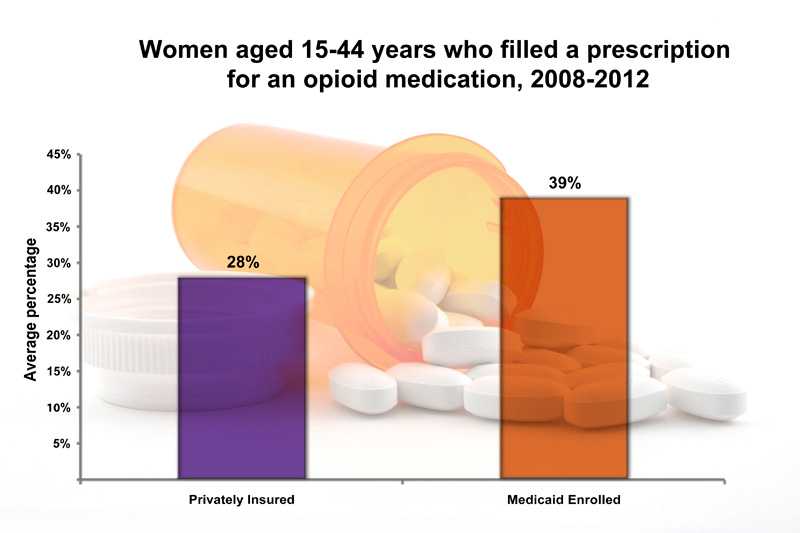Key Findings: Opioid Prescription Claims among Women of Reproductive Age

Talk to your healthcare provider! Pregnant or thinking about pregnancy? Don’t stop or start taking any medications without first talking with a healthcare provider.
CDC’s Morbidity and Mortality Weekly Report published a new study looking at how often women aged 15-44 years filled a prescription for specific pain medications, called opioids. CDC researchers found that during 2008–2012, on average, 28% of women aged 15-44 years with private health insurance and 39% of women with Medicaid filled a prescription written by a healthcare provider for an opioid medication. This is important information for healthcare providers, pharmacists, and women, because taking these medications early in pregnancy, often before women know they are pregnant, can increase the risk for some birth defects and other poor pregnancy outcomes (such as preterm birth or low birth weight). You can read the article here, and read more below for a summary of this study’s findings.
Main Findings
- During 2008-2012, more than one-quarter of privately insured and over one-third of Medicaid-enrolled women aged 15-44 years filled a prescription written by a healthcare provider for an opioid medication.
- The most commonly prescribed opioids were hydrocodone, codeine, and oxycodone.
- Women aged 30–34 years with private health insurance and women aged 40–44 years with Medicaid were more likely to fill prescriptions for opioids compared with women of other ages.
- More work is needed to promote interventions to reduce opioid prescriptions among women, when safer alternative treatments are available.

About this Study
- Researchers used 2008-2012 data from two large insurance claims datasets: one of women with private health insurance and another of women with Medicaid.
- Researchers looked for opioid prescriptions filled at outpatient pharmacies by women aged 15 to 44 years.
- Researchers also looked at how health care coverage type, specific opioid medication type, and a woman’s age were related to filling a prescription for an opioid.
Medication Use during Pregnancy: CDC’s Activities
About Opioids
- Opioids are prescription medications that are commonly prescribed by healthcare providers to treat moderate to severe pain. Opioids are also found in some prescription cough medications.
- Opioids include medications like codeine, oxycodone, hydrocodone, or morphine.
- Previous studies of opioid use in pregnancy suggest that these medications might increase the risk for neural tube defects (major birth defects of the baby's brain and spine), other birth defects, and poor pregnancy outcomes (such as preterm birth or low birth weight).
CDC’s National Center on Birth Defects and Developmental Disabilities (NCBDDD) is working to improve the health of women and babies through its Treating for Two: Safer Medication Use in Pregnancy initiative. Through Treating for Two, CDC is working with its partners, other federal agencies, and the public to understand trends in medication use among pregnant women and women of reproductive age and to provide women and healthcare providers with information about the safety or risk of using specific medications during pregnancy. This information will allow women and their doctors to make informed decisions about treating health conditions during pregnancy.
Treating for Two focuses on the following activities:
- Better research: Treating for Two is working to expand research on medication use and pregnancy outcomes.
- Reliable guidance: Treating for Two is building the foundation to establish a process to review evidence and develop guidance for treating conditions in pregnancy.
- Informed decisions: Through these activities, Treating for Two will provide credible and reliable information to healthcare providers and the public to support treatment decisions in pregnancy.
More Information
- For more information about medications and pregnancy, visit www.cdc.gov/pregnancymedication or www.cdc.gov/treatingfortwo
- Have questions about how medications you are taking may affect a pregnancy? MotherToBaby.org can help you find the answers to your questions.
- To learn more about CDC’s work on birth defects, please visit http://www.cdc.gov/ncbddd/birthdefects/
- On January 9,, 2015, FDA released a new Drug Safety Communication on Pain Medicine Use during Pregnancy. For more information, visit http://www.fda.gov/Drugs/DrugSafety/ucm429117.htm
- If you are a healthcare provider, visit these CDC Expert commentaries on medications and pregnancy:
- Medication use in pregnancy: http://www.medscape.com/viewarticle/738087?src=par_cdc_stm_mscpedt&faf=1
- New Medscape commentary coming in January.
- Did you know that deaths from opioid-related drug overdoses among women have increased more than 400% over the last decade? To learn more about CDC’s work on prescription drug overdose visit: http://www.cdc.gov/vitalsigns/PrescriptionPainkillerOverdoses/index.html
Key Findings Reference
Ailes EC, Dawson AD, Lind JN, Gilboa SM, Frey MT, Broussard CS, and Honein MA. CDC. Opioid prescription claims among women of reproductive age — United States, 2008–2012. MMWR. 2015 Jan 23;64(2):37-41.
- Page last reviewed: January 22, 2015
- Page last updated: November 1, 2016
- Content source:


 ShareCompartir
ShareCompartir